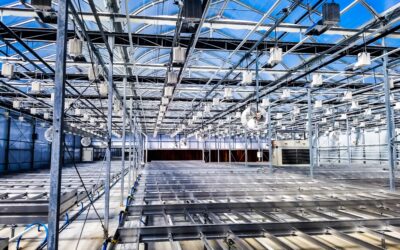For commercial growers, greenhouse irrigation is one of the most important variables. Irrigation is also a great place to begin to incorporate automation, which can provide significant labor savings. Proper greenhouse design can facilitate smart irrigation design.
Precision in your irrigation protocol demands a granular understanding of dynamic crop needs, water dynamics, and technological integration. Dialing in your approach will help you achieve optimal growth conditions, conserve resources, and maximize yield quality and quantity.
Deciphering Plant Water Requirements for Greenhouse Irrigation
At the core of effective greenhouse irrigation design are your crop’s fertigation needs. You may be growing poinsettias, cannabis, or tomatoes: Those plants’ needs will dictate your standard operating procedures, of course.
This involves an analytical approach to quantifying crop water use. Consider high-level factors such as plant species, growth stage, and environmental conditions within the greenhouse.
Technical Insights:
- Crop-Specific Analysis and Measurement Techniques: To dial in your greenhouse irrigation protocols, review each plant variety’s requirements. Consider the growth stage and environmental conditions. Use advanced measurement techniques, such as evapotranspiration (ET) monitoring using plant weighing scales or phloem sensors. This allows for an accurate assessment of water loss and precise adjustment of irrigation schedules accordingly.
- Development of Standard Operating Procedures (SOPs): To optimize irrigation design and support healthy plant growth, develop SOPs outlining specific fertigation protocols for each crop. These procedures incorporate data-driven insights and environmental factors to ensure efficient nutrient delivery while conserving water and minimizing environmental impact. Regular monitoring and adjustment based on crop health and environmental parameters are integral to maintaining effective irrigation practices.
Ensuring Water Quality and System Compatibility
The foundation of effective irrigation design also rests on the assessment and management of your actual water quality. Where are you sourcing your water? This is a critical question for growers of all stripes.
Make sure that your water source is compatible with both your crop needs and your irrigation infrastructure.
Technical Insights:
- Water Quality Analysis and Treatment Protocols: Develop a comprehensive water quality management strategy that includes regular analysis for pH, electrical conductivity (EC), and specific ion toxicity. Tailor treatment solutions (such as acid injection for pH adjustment or advanced filtration for removing particulates and pathogens) to ensure water quality aligns with both crop tolerance and system durability.
- System Material Selection Based on Water Chemistry: Choose greenhouse irrigation system components that are resistant to corrosion, scaling, or clogging based on the specific chemistry of your water source. This includes selecting appropriate materials for pipes, emitters, and filters. Those components must withstand long-term exposure to the water’s chemical makeup. Your greenhouse design partner can help with this selection process!
Integrating Cutting-Edge Irrigation Technologies
Automation technology can be indispensable when you’re managing irrigation protocol at scale. Embrace precision control technology and a sense of data-driven management. How your team manages its irrigation should reflect its broader culture and operational ethos.
Technical Insights:
- Automated Irrigation Control Systems: Invest in irrigation systems that integrate with climate control software, allowing for dynamic adjustments based on environmental conditions, soil moisture levels, and plant growth models. This facilitates the delivery of water and nutrients in precise quantities at optimal times, enhancing plant health and resource utilization.
- Advanced Fertigation and Chemigation Solutions: Leverage precision fertigation systems that can accurately dose nutrient solutions based on real-time plant uptake and soil fertility assessments. Incorporate chemigation protocols for the targeted application of crop protection agents through the irrigation system, ensuring effective pest and disease management while minimizing environmental impact.
READ MORE: 8 Tips for Proper Spring Greenhouse Maintenance
Prioritizing Sustainable Practices
In irrigation design, sustainability involves conserving water and managing resources efficiently to reduce environmental impact
Technical Insights:
- Recycling and Reclamation of Water and Nutrients: Implement systems for the capture and treatment of runoff and condensate water for reuse. Reuse of irrigation run-off and condensate requires filtration, sterilization, and nutrient recovery technologies to ensure the recycled water meets quality standards for irrigation.
- Renewable Energy Integration: Explore regional opportunities for powering irrigation systems using renewable energy sources, such as solar or wind power. This approach reduces the greenhouse operation’s carbon footprint and can offer long-term cost savings on energy expenditures.
Committing to Continuous System Evaluation and Improvement
The dynamic nature of greenhouse operations and the continuous evolution of technology call for an ongoing commitment to the evaluation and enhancement of irrigation systems.
Like anything else in the greenhouse, your work is never truly done!
Technical Insights:
- Regular System Audits and Performance Analytics: Conduct thorough audits of irrigation system performance, including uniformity tests, system pressure and flow measurements, and efficiency evaluations. Utilize data analytics tools to analyze performance trends, identify areas for improvement, and inform system upgrades or adjustments.
- Professional Development and Knowledge Sharing: Foster a culture of continuous learning within your team. Do this by encouraging advanced training in irrigation technology, system design, and water management.
Sign up for the LLK Greenhouse Solutions newsletter below >>>


